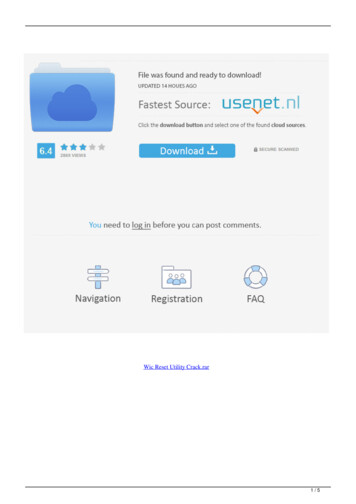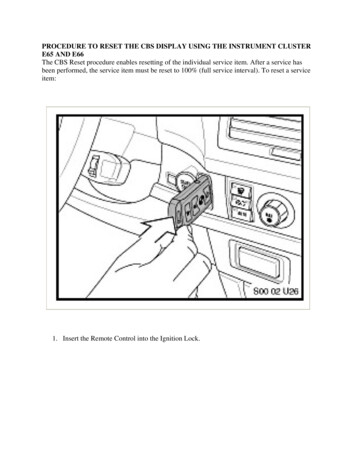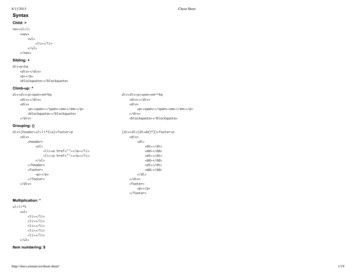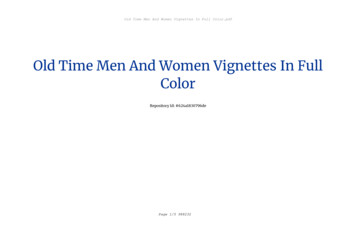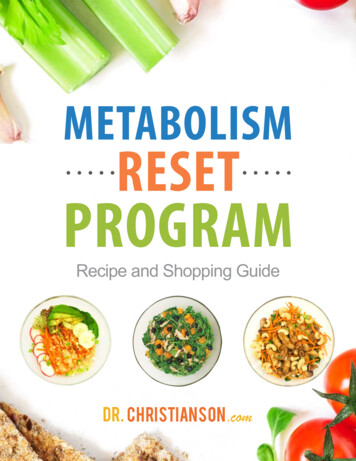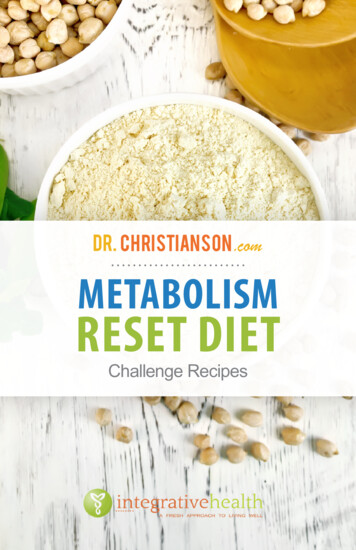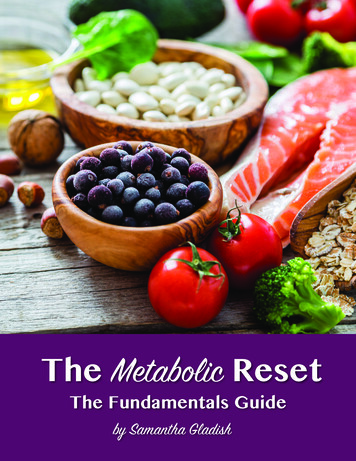
Transcription
The Metabolic ResetThe Fundamentals Guideby Samantha Gladish
The Metabolic Reset Fundamentals Guide2HI AND WELCOME!Welcome!I’m so excited to have you apart of the Metabolic Reset (MR for short) community! Ifyou’ve found your way here, you are probably a lot like so many of my clients - You’vespent what feels like your entire LIFE looking at a cupcake and gaining 4 lbs, carryingfood with you wherever you go in case you get hungry (and lightheaded, and reallycranky) and fighting insane cravings for chips, chocolate, crackers or cheese.But. I’ve got great news for you! It doesn’t need to be this hard. And it doesn’t meanyou have to give up all of your favorite foods just to lose a pound.The beauty of the Metabolic Reset is that it contains foods that work better for yourbody from a physiological and hormonal standpoint. Stick with me, and you’ll finallybe able to gain health, lose weight, balance blood sugar, and balance your hormonelevels without having to starve yourself. For the first time, food won’t dominate yourthoughts all day long.Here’s what I need you to do next:Read through this entire guide along withthe additional handouts you received. Theinformation contained in this guide will help youto better understand why this program works,along with helping you learn some of the keyterms you will see throughout this program.Understanding the what and why behind anyprogram you are doing is critical to you staying onthe path to success!And remember, I’m always here cheering you on,supporting you and celebrating every win, so besure to connect with me and the rest of the community inside our private Facebook group. Stayingconnected and accountable will help you achieveyour goals faster!Cheers and Congratulations for taking this bigstep towards better health!- Samantha Gladish,www.holisticwellness.caRHNMedical DisclaimerAll information contained in the Metabolic Reset program is for informational purposes only. It is not intended to diagnose,treat, cure or prevent health problems. For all serious health issues, please contact a medical or nutrition practitioner. Theinformation provided in this program is based on the best knowledge of the author at the time of writing and we do notassume liability for the information within this program, be it direct or indirect, consequentially, special exemplary or otherdamages. In all circumstance, it is always wise to consult your physician before changing your diet, taking supplements orstarting any exercise or health program.Samantha Gladish, RHN www.holisticwellness.ca Copyright 2018
The Metabolic Reset Fundamentals GuideChapter 1:The Basics of Fat Burning, Blood SugarBalance, and HormonesSamantha Gladish, RHN www.holisticwellness.ca Copyright 20183
4The Metabolic Reset Fundamentals GuideChapter 1: The Basics of Fat Burning, Blood Sugar Balance, and HormonesIn this program, we are learning how to burn fat more effectively by balancing bloodsugar and hormones. Below, I’m going to explain how this works, so let’s dive in:Fat burning and fat storing are two different metabolic and hormonal states. Thinkof them as one-way streets. You can’t be on both at the same time as they are mediated by hormones, which are counterparts (this means when one is low the other ishigh and vice versa). The MR teaches you to use the right macronutrients to burn fatinstead of storing more.Let’s break that down further: Your body can use two different pathways to producethe energy you need from the food that you eat. First of all, your main energy sourceis glucose and glucose is found in carbohydrates. You’ve probably heard of simpleand complex carbs, right? The simpler the carb (ie. like a piece of white bread), thefaster your body can digest it, and the faster glucose is sent into your bloodstreamand then delivered to the cells for energy.With me so far? Ok good (assuming a yes here).When all that energy (ie. sugar) is sent into the bloodstream at once it forces yourpancreas to produce insulin. Insulin is sent to take that sugar (energy) to the workingmuscles to provide them with the fuel to keep going.But here’s the problem. when your muscles aren’t working very hard (i.e., you’re sitting on the couch, at your desk, at the dinner table, etc.), your muscles say ‘no thanks’to the offer of more energy (sugar). They just don’t need it! Plus, their back up storesare already full as is (from consuming too many carbohydrates to begin with) andinsulin then moves on to store that energy (glucose) as fat.Because guess what? Insulin is your main fat storing hormone.The second part of this problem is the speed that the carbs were digested. Becausethey digested so quickly, all of the energy was sent into your bloodstream at once. Insulin then came and removed it (again-all at once), and now your blood sugar is toolow. What happens next? You crave more carbs to quickly raise blood sugar back up;this puts you into the never-ending cycle of craving carbs and gaining weight. This isthe problem with consuming a diet heavy in carbohydrates (aka the way 99% of useat).Unless you are extremely active, odds are you aren’t able to use up all of that fuelthat’s released at once when you eat a lot of carbohydrates. If you are trying to loseweight, the picture gets even bleaker. Because you’re relying so heavily on carbohydrates and not moving enough to use all of the sudden bursts of energy (ie. glucose/sugar), your body has a lot of insulin pumping through on a regular basis.Samantha Gladish, RHN www.holisticwellness.ca Copyright 2018
The Metabolic Reset Fundamentals Guide5Chapter 1: The Basics of Fat Burning, Blood Sugar Balance, and HormonesHigh amounts of insulin in the body can lead to some pretty nasty complicationsdown the road, think insulin resistance, PCOS, metabolic syndrome and type 2 diabetes. Not to mention, weight gain, terrible PMS, acne, low energy, mood swings andirritability.High insulin levels contribute to you staying in fat storage mode (insulin is your fatstorage hormone) instead of fat burning mode (a way of operating that’s modulatedwith a hormone called glucagon which is basically your fat burning hormone). Insulin and glucagon are counterparts, so when one is high the other, naturally, is low.Let’s move on to fat and protein. Fat and protein operate a little differently. They aredigested much more slowly than carbohydrates are because they are more complicated molecules, and it takes your body longer to break them down. When youeat fat and protein, your blood sugar stays in a more stable state (i.e., no highs, lows,cravings and crashes).How Fat Storage WorksAs we evolved, we as a species experienced a lot of feast and famine, meaning wehad periods with ample food and periods with almost no food. Because of this, weevolved a way to store our food during times of feast to then use during times offamine. This storage system is fat.Now, once fat is stored, your body wants to conserve it until a time when it’s reallyneeded, aka. famine. The cue that was developed to access stored body fat was thelack of carbohydrates/glucose and therefore a lack of insulin, NOT the lack of caloriesprovided through food.This is why it can be so darn hard to lose fat on a traditional low calorie diet. Eventhough calories are minimized, there is still a constant influx of sugar to the blood(through carbohydrates), which then causes insulin to be released. While insulin ishigh, glucagon (aka the hormone that mediates burning fat for fuel) is low (remember these two hormones are counterparts) and dipping into fat for fuel becomesvery difficult.This means that if we want to effectively tap into stored fat for fuel, we need torecreate the famine state, not through lack of calories but through low insulin andtherefore high glucagon.Samantha Gladish, RHN www.holisticwellness.ca Copyright 2018
The Metabolic Reset Fundamentals Guide6Chapter 1: The Basics of Fat Burning, Blood Sugar Balance, and HormonesThe presence of ketones is the hallmark sign that your body is using fat for fuel BUTit’s not an all or nothing, and you can still burn fat for fuel effectively without havingmeasurable ketones in your system. This would be the goal of a high-fat low-carb(HFLC) program. It’s a slow and steady fat burning adaptation via balanced bloodsugar and low insulin. YAY!That’s why we start by paying close attention to the amount of carbohydrate we eat.By doing this, we avoid spiking insulin and keep glucagon in the driver’s seat. Theamount of carbohydrate needed in a day depends on your unique tolerance andyour goals.And that’s it! That’s as much as you NEED to know about the science! Read on formore benefits!Benefits of a High-Fat Low-Carb DietThe biggest benefit to adopting a high-fat low-carb diet to your goals in everydaylife is weight loss. Studies have shown that stabilizing blood sugar and hormones ismore effective than the traditional low-fat diets when it comes to weight loss. Studies have also found that high-fat and ketogenic diets decrease hunger by impactinghormones such as ghrelin.By now this approach should make total sense after reading the backstory. If itdoesn’t, go back and read it again, unless you honestly don’t care WHY and just wantto get to the HOW (totally ok by the way!). Eating in a high-fat low-carb way is reallyfilling, so you naturally tend to eat less without having to restrict or count calories(huge bonus!). In fact, in just 2 weeks, clients have reported less cravings for carbohydrates and more sustained energy.Also, this way of eating results in lower and more stable insulin levels, which leavesyou less hungry and prone to those late night carbohydrate cravings.From my personal experience, the big difference is that your meals really fill you up(in a good way). You aren’t hungry for HOURS after you eat, and most people onlywant to eat 2 or 3 meals a day. It all makes sense when you remember that fat andprotein take a lot longer to digest than carbohydrates AND leave you with stableblood sugar (the KEY to managing hunger and avoiding the diet-destroying cravings). Also, when your body needs more energy all it has to do is turn to that storedfat that you’re dying to get rid of.Of course, there are other huge advantages to this way of eating. There are cardiovascular benefits, as studies have found that triglycerides and HDL cholesterol haveboth improved in patients following a high-fat low-carb diet compared to a traditional low-fat diet. Because this type of diet improves insulin levels and leads to fatloss, it has been very successful in patients with Type 2 Diabetes. Tapping into ketosishas also shown promise in certain cancers, Alzheimer’s, epilepsy, PCOS, heart diseaseand more.Samantha Gladish, RHN www.holisticwellness.ca Copyright 2018
The Metabolic Reset Fundamentals GuideChapter 2:DefinitionsSamantha Gladish, RHN www.holisticwellness.ca Copyright 20187
The Metabolic Reset Fundamentals Guide8Chapter 2: DefinitionsMacros: Also known as macronutrients these are the building blocks to food. Fat,protein, and carbohydrates are the macronutrients we need to eat every day. Thisprogram is all about balancing these macronutrients, so your body switches over tothe metabolic pathway that burns fat for energy.Carbohydrate: One of the three macronutrients and needed for a balanced diet.Carbohydrates come in the form of fruit, grain, sugar, vegetable, or starch like sweetpotatoes or corn. Energy from carbohydrates are stored in the body as glycogen, andwe can’t store a lot of glycogen, so when our body stores are full, energy from carbohydrates are then stored as fat.Net carbs: Are the total carbohydrates consumed minus the fiber content. We measure this because fiber passes through the digestive tract without being absorbedand therefore doesn’t affect the amount of glucose or sugar that enters the bloodstream.Fat: The major store of energy in humans, animals or plants. One of the three macronutrients and needed for a balanced diet. Fat is also important for balancing hormones, fueling the brain, nourishing the skin and supporting satiety.Protein: A nutrient found in food, made up of amino acids and necessary for cellstructures and function. One of the three macronutrients and needed for a healthydiet.Ketosis: The metabolic state where your body burns fat instead of carbohydrates forfuelKetones: Molecules created by the liver to be used by fuel for the body, especiallythe brain.Fat Adaptation: This is what happens when you burn fat for energy instead of carbohydrates. This is the entire point of this program so we’ll devote a bit more time to it.(As a note - this is not a full-on ketogenic program and I won’t be asking you to measure your ketone levels, but this is a high-fat-low-carb program).Samantha Gladish, RHN www.holisticwellness.ca Copyright 2018
The Metabolic Reset Fundamentals GuideChapter 3:Fat AdaptionSamantha Gladish, RHN www.holisticwellness.ca Copyright 20189
The Metabolic Reset Fundamentals Guide10Chapter 3: Fat AdaptionThis is probably the biggest question I get: “How do I know if I’m burning fat forenergy (aka fat adapted)?” Knowing when your body is fat adapted is key because itlets you recognize what healthy burning fat for fuel feels like, so you can experimentwith different macronutrient ratios as you work through the program. Recognizingfat adaption is also important for knowing when to make changes (you don’t wantto change anything until your body gets to the point of being fat adapted). The timeframe for this is different for everyone but generally ranges between 10 and 30 days.Signs you are fat adapted: You are not hungry all the time.You can go 4 to 6 hours between meals with no need for snacking.Your body craves fat instead of sugar.You don’t get ‘hangry’ anymore.Your energy is stable all day long (no afternoon crashes).Your energy level is up significantly.You don’t experience any brain fog, and your thoughts seem clearer.Getting Enough FatStep 1 is to start buying full-fat products instead of the low fat, no taste, heavilyprocessed versions advertised as healthy. That means full-fat dairy (if you do dairy),full-fat mayo (preferable avocado mayo), and fatty cuts of meat (chicken thighs withskin instead of skinless, boneless chicken breasts, regular ground beef instead oflean, etc.).A word to the wise here, toxins are stored in fat. Make sure you are buying the bestquality meat and dairy you can afford when you’re choosing full-fat options. It’smuch better to eat great quality meat less often than low-quality meat daily.Make your hot beverages (like coffee and tea) full of delicious fat. I always add atablespoon of coconut oil into my coffee (or tea) and blend. You can also make theSupercharged Coffee recipe as well (recipes are found in the meal plans).Make Chia water. Just add a scoop of chia seeds to your water along with a squeezeof lemon juice or some mint, etc. Sip away knowing that even your water is nowworking for you!Always add olive oil or butter to your vegetables to give them flavor and up the fatcontent. Make your own salad dressings using lots of oil and flavored vinegar such asbalsamic or red wine vinegar.Choose fatty fish such as, salmon, mackerel or anchovies.Samantha Gladish, RHN www.holisticwellness.ca Copyright 2018
The Metabolic Reset Fundamentals Guide11Chapter 3: Fat AdaptionEat avocado mayo. It goes well with just about anything. You can buy avocado mayoat most grocery stores and health food stores.Whip up a batch of my fat bombs (recipe in the meal plans) and snack on themwhen you’re feeling hungry.Getting Rid Of Excess CarbsStep 1 is to hit the brakes on processed foods. That’s right, you don’t want anythingfrom a box or a bag for the most part. If you’re eliminating processed foods, youdon’t have to worry about added sugars or other sweeteners. It makes things somuch easier!This might be obvious but ditch the sugar in your coffee (or anywhere else you useit). For now, you can make the switch to Stevia or Lakanto (my favorite) as your sweeteners of choice. As your taste buds adapt to your new sugar-free life, you’ll need lessand less until you can eventually ditch it altogether.You also need to watch your fruit intake and switch to the occasional low sugar option like berries or green apples. Read through the food lists in the program. Familiarize yourself with the low carb vegetables because these babies will be your bestfriends. Include one or more with every single meal (and try to aim for variety).Now it’s time to go grain free. Right now it’s important to stay away from things likebread, pasta, wraps, toast, rice, lentils, barley, etc., etc., etc. I know, that’s a LOT to stayaway from, BUT this isn’t forever. This is only while you get fat adapted. After that,there is MUCH more flexibility regarding occasional choices.AlcoholYes, you can still have alcohol on this program, but you have to choose the right type.If you like wine, go for it, but a serving is around 4g of carbs so factor that into yourday. Don’t be tempted to over pour and have two servings at once. Also, buy the driest wine you can (remember sugar is carbs). Read your labels - the wine you chooseshould have less than 5g/L of sugar. You want to avoid regular beer at all costs (veryhigh in carbs). Drink low-carb beers, and you can get away with 1-3g/serving. If youwant to drink liquor, you’re in luck! Vodka and gin are carb-free! You just need to pairthem with zero-carb mixes. I suggest club soda with a squeeze of lemon juice. Youcan add a bit of stevia if you like it a bit sweeter.Just beware, alcohol will affect you much more on a high-fat low-carb diet so drinklots of water in between drinks and plan on drinking less than you normally would.Also, your body will preferentially burn alcohol over fat, so while you are drinkingyour body does stop burning fat for fuel. The more you drink, the longer this effectlasts. If fat loss is your goal, I suggest you limit alcohol for the next 12 weeks (or longer).Samantha Gladish, RHN www.holisticwellness.ca Copyright 2018
12The Metabolic Reset Fundamentals GuideChapter 4 & 5:The Action Plan & Your Path To SuccesSamantha Gladish, RHN www.holisticwellness.ca Copyright 2018
The Metabolic Reset Fundamentals Guide13Chapter 4: The Action PlanOur action plan is officially called The Metabolic Reset 12-Week Program.This pathway is a really simple and moderate way to go. This is not a ketogenic dietwhere you enter a state of full ketosis, but you will be eating high-fat, moderateprotein, and low-carb. Your results will be consistent. This is also a great way to eatindefinitely, so you’re really accomplishing a lifestyle change. There’s an entire manual devoted to the overview of your program so stay tuned!Chapter 5: Your Path To SuccessThis program is a 12-week step-by-step program designed to slowly help you implement new habits following the principles of a high-fat low-carb dietary approach.The key is to follow the program week-by-week but don’t stress if you can’t implement everything that is suggested. Just do what you can and move through theprogram at whatever pace is comfortable for you, what feels good for YOUR bodyand YOUR lifestyle.When you have questions, post them in the private Facebook community. This iswhere all questions are to be asked and answered. No question is stupid, and norequest for support will go unanswered. I am here to make SURE you see success.Period. If you’re having a hard time, make sure to post that you are struggling. Ifsomething doesn’t make sense, ask for clarification.Our Facebook group community is a secret weapon and the difference betweenhuge success and giving up for many people. Community and asking for help is key.Be sure to read through all your handouts, familiarize yourself with your meal plan,get prepped and prepared (which is half the battle) and get ready to lose weightwhile eating delicious food!All the best on your NEW Health Journey!Samantha Gladish, RHN www.holisticwellness.ca Copyright 2018
The beauty of the Metabolic Reset is that it contains foods that work better for your body from a physiological and hormonal standpoint. Stick with me, and you’ll finally be able to gain health, lose weight, balance blood sugar, and balance your hormone levels without having to star
